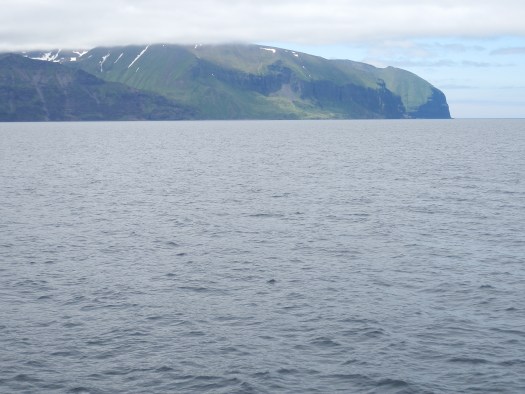NOAA Teacher at Sea
Lee Teevan
Aboard NOAA Ship Oscar Dyson
July 1-10, 2018
Mission: Acoustic Pollock-Trawl
Geographic Area of Cruise: eastern Bering Sea
Date: 13 July 2018

Weather Data from Norfolk, VA
Latitude: 36.8508° N
Longitude: 76.2859° W
Tide Heights: 2.76 ft & 3.35 ft
Wind Speed: 19 km/h
Wind Direction: NE
Air Temperature: 28°C, 82°F
Barometric Pressure: 1028.1 mb
Sky: Clear
Humidity: 76%
“If you’re awake at 6:00 a.m., you’ll get to see the Oculus as I prepare it to glide around in the Bering Sea!” With this promise from Dr. Chris Bassett, I made sure I was ready at the appointed time on our last day on the ship.

The launching of the Oculus was not on Chris’ schedule for that day beforehand; our expedition was ending earlier than expected. That setback, however, did not diminish the drive to pursue science. The resilience and perseverance of the science team to readjust was apparent. Through the mist of disappointment, the scientists continued to do as much as possible to continue our mission of the pollock survey.
Science and Technology Log
Developed at Pacific Marine Environmental Laboratory in partnership with the University of Washington’s Joint Institute for the Study of the Atmosphere and Ocean and the University of Washington Seaglider Fabrication Lab, the Oculus is an ocean glider which samples abiotic factors in the ocean such as temperature, salinity and dissolved oxygen at different depths.

After setting the Oculus upright, Chris connected it via the Internet to a computer operated by a scientist at the University of Washington. This scientist is going to be sending coordinates to the Oculus and guiding it at various depths in the Bering Sea. Chris explained that the Oculus has the ability to adjust its buoyancy quickly and is able to carry out a more reliable survey than other gliders. Through the data remotely sent by the Oculus, scientists can gather a more accurate picture of ocean dynamics such as water column layers and ocean mixing.
Unfortunately, I was not able to observe the launch of the Oculus as I had to leave for the airport.
Personal Log

The week I spent on the ship was a whirlwind of experiences. I was just hitting my stride being completely awake for my 4:00 a.m. to 4:00 p.m. work shift and efficiently measuring the length of the pollock in each trawl.

At the end of the last trawl, I held a pollock, out of its element of water. Its dense, streamlined body shimmered with iridescence. One eye stared, unfocused on the strange surroundings. I too would be out of my element were it not for the 208.6 ft. boat on which I was standing. Being on the boat was a constant reminder that my species is alien to this ocean habitat and that to explore it, we have to use technology such as the Oculus, underwater cameras, and acoustic technology as well as physical trawls. Together, these different means of exploring combine information so that we can evaluate our interactions with the ocean and its inhabitants.

At times, the ocean had a disorienting effect. When on the deck, I looked out from all directions and saw nothing but ocean capped by a dome of stratus clouds. Under this lid of heavy clouds, the sun gave no clue to discern our direction or time of day.
Marine Careers

With her philosophy of focusing on the positive, Karla Martinez enjoys her time on and off duty on the Oscar Dyson. As a Junior Engineer, Karla is responsible for ship upkeep and repairs. On our last day of the trip, I spoke to her as she changed air filters in all of the staterooms. Karla began working as a NOAA Junior Engineer three years ago after seven years in the U.S. Navy. Since working for NOAA, she has traveled extensively and makes sure she visits each place the Oscar Dyson docks. Karla is on the ship for at least 7-8 months of the year, and she makes the ship feel like home by getting to know people.

For young people who are interested in a career like Karla’s, she advises asking many questions and studying technology as much as possible. In high school, students should take the ASVAP test before entering the military. Once admitted to the military, students should get trained. Karla states that students should talk to their counselors and find out all they can.











